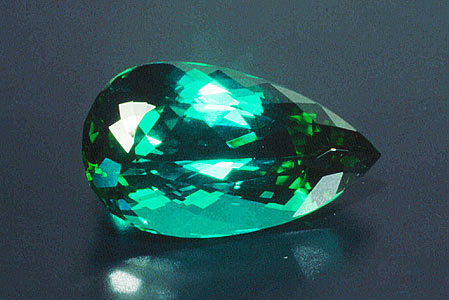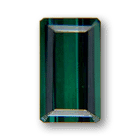 FREE SHIPPING on US orders over $150. Need help? Contact Us
FREE SHIPPING on US orders over $150. Need help? Contact Us Genuine Green Tourmaline Gemstone

Green Tourmaline (Pronunciation: \'tur-mə-lən, -'lēn\)
Tourmaline is a virtually unique colour miracle : this gemstone exists in red and green, blue and yellow, and even in colourless and black respectively. Often there are even two or more colours displayed in one and the same Tourmaline crystal. Highly coveted rarities are colour changing Tourmalines or chattoyant ones. However, the classical colour for Tourmaline is green. And if you ask gemstone dealers for Tourmaline, the green variety will almost inevitably be the first one to come to their minds.
Nevertheless, even the green Tourmalines come in a wide range of shades. Some are very light, others are so dark that the green colour is only discernible when light is shone through the stone. There are green Tourmalines in fine leek-green shades, but there are also intensely coloured yellow-green, olive-green and brownish-green stones. And especially the colour range from blue-green to darkest bottle-green is covered spectacularly by wonderful Tourmalines, for these colours are the best for these stones. They are rare and highly coveted. Tourmaline is loved as a perfect jewellery stone by many women, but it has also come to be preferred nowadays by quite a few men.
Why Brazilian Tourmaline might come from Africa

Sometimes Tourmalines are offered by traders with an additional byname, which at first sight seems to explain the stone’s origin. For example, bottle-green Tourmaline might also be offered as "Brazilian Tourmaline”. Here it should be noted that this does not necessary imply that the stone was actually mined in Brazil. In the past it was considered a rigid fact that all bottle-green Tourmalines came almost exclusively from Brazil, while blue-green to green shades were usually found in Africa. Today things have changed, but the trade names have been kept so that bottle-green Tourmalines are still called "Brazilian” and bluish-green ones "African” Tourmalines, irrespective of the actual place of origin. Another rarely used name which is generally applied only among experts is the term "Verdelith". It has been composed from the Latin word "viridis” for "green” and the Greek suffix "lith” meaning "stone”. But in general we talk about green Tourmaline.
Chromium makes green Tourmalines resemble Emeralds
Tourmalines are complex borosilicates . The different colours are in fact caused by minute traces of other material in smallest quantities. Due to the complex structure of this gemstone it exists in many different varieties and shades, depending on where it grew. This individuality is very fascinating, since each place of occurrence brings forth a special kind of Tourmaline. With a little bit of luck you will discover one or the other rare Tourmaline highlight on the market: the precious Chromium-Tourmaline. This is the trade name for the emerald-green Tourmaline variety from Tanzania which owes its colour to traces of Vanadium and Chromium. Its colour is outstandingly beautiful and strikingly similar to the colour of fine Emerald, which is in turn one of the most expensive gemstones in the world.
 Tourmalines are found almost everywhere on the globe as small and usually dark crystals. However, those locations where large and beautiful crystals can be mined , which are worth being cut into splendid jewels, are rather rare indeed. The most important occurrences are located at Brazil, Namibia, Nigeria, Mozambique, Pakistan and Afghanistan. But in good colour and transparency Tourmalines are rarely found in all these gemstone mines. And should they show hardly any inclusions at that, they will be very highly treasured.
Tourmalines are found almost everywhere on the globe as small and usually dark crystals. However, those locations where large and beautiful crystals can be mined , which are worth being cut into splendid jewels, are rather rare indeed. The most important occurrences are located at Brazil, Namibia, Nigeria, Mozambique, Pakistan and Afghanistan. But in good colour and transparency Tourmalines are rarely found in all these gemstone mines. And should they show hardly any inclusions at that, they will be very highly treasured.
Not easy to cut
Green Tourmalines can be cut in many different variations. However, this demands a high degree of craftsmanship and expertise, since most Tourmalines show a varied colour satiation throughout the crystal depending on the axis of growth. Therefore, then, dark stones have to be cut in such a way that the table will be parallel to the main axis. In contrast to this, for lighter coloured stones the table should be parallel to the longitudinal axis in order to achieve a deeper colour. The cutter has to keep this characteristic well in mind when planning and executing the cut, since otherwise the colour of the cut stone might end up too dark or to pale. And that would be a real shame, because you need not be a gemstone expert in order to appreciate the fascination of green Tourmalines. The colours are wonderfully harmonic and pleasant, almost spiritual. Green Tourmalines are an epitome of life, encompassing all its facets of vivid individuality.



